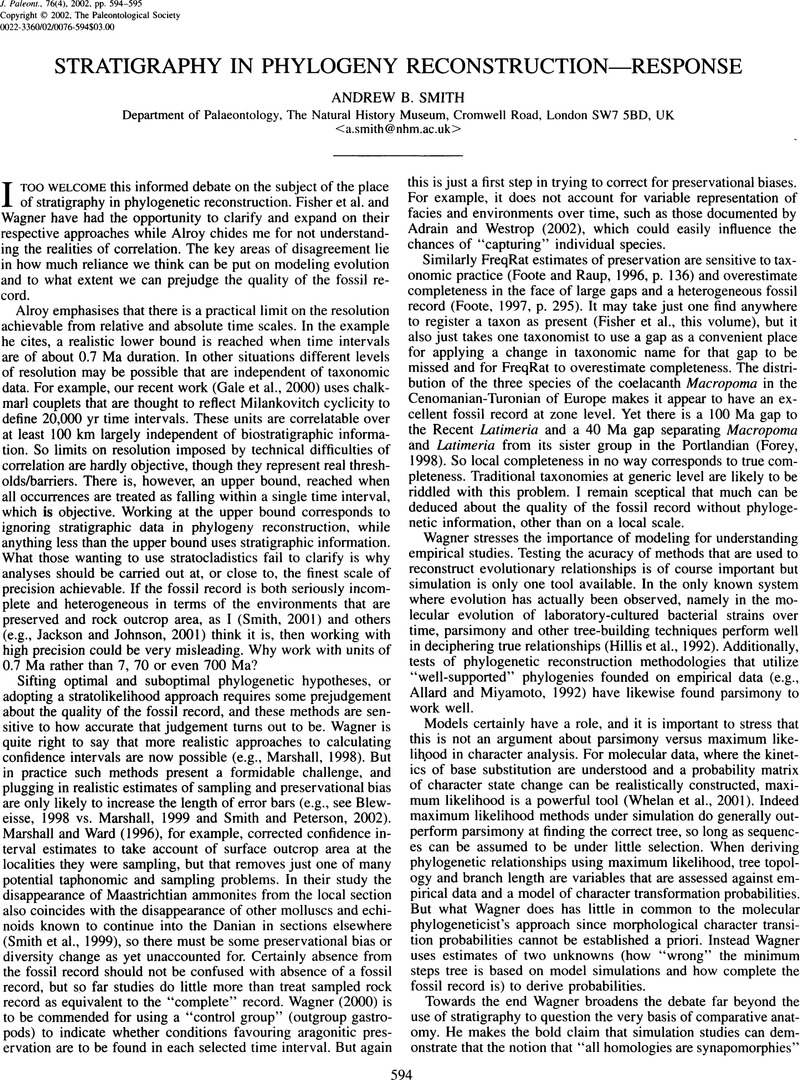No CrossRef data available.
Article contents
Stratigraphy in phylogeny reconstruction—response
Published online by Cambridge University Press: 14 July 2015
Abstract
An abstract is not available for this content so a preview has been provided. Please use the Get access link above for information on how to access this content.

- Type
- Comment and Reply
- Information
- Copyright
- Copyright © The Paleontological Society
References
Adrain, J. M., and Swestrop, S. R.
2001. Stratigraphy, phylogeny, and species sampling in time and space, p. 291–322. In
Adrain, J. M, Edgecombe, G., and Lieberman, B. (eds.), Fossils, Phylogeny, and Form: An Analytical Approach. Topics in Geobiology, 19. Kluwer Academic/Plenum Publishers, New York, 402 p.CrossRefGoogle Scholar
Allard, M. W., and Miyamoto, M. M.
1992. Testing phylogenetic approaches with empirical data, as illustrated with the parsimony method. Molecular Biology and Evolution, 9:778–786.Google ScholarPubMed
Bleiweiss, R.
1998. Fossil gap analysis supports early Tertiary origin of trophically diverse avian orders. Geology, 26:323–326.2.3.CO;2>CrossRefGoogle Scholar
Farris, J. S., Kallersjo, M., Kluge, A. G., and Bult, C.
1994. Testing significance of incongruence. Cladistics, 10:315–320.CrossRefGoogle Scholar
Foote, M.
1997. Estimating taxonomic durations and preservation probability. Paleobiology, 23:278–300.CrossRefGoogle Scholar
Foote, M., and Raup, D. M.
1996. Fossil preservation and the stratigraphic ranges of taxa. Paleobiology, 22:121–140.CrossRefGoogle ScholarPubMed
Gale, A. S., Smith, A. B., Monks, N. E. A., Young, J. A., Howard, A., Wray, D. S., and Huggett, J. M.
2000. Marine biodiversity through the late Cenomanian–Early Turonian: palaeoceanographic controls and sequence stratigraphic biases. Journal of the Geological Society, 157:745–757.CrossRefGoogle Scholar
Hillis, D. M., Bull, J. J., White, M. E., Badgett, M. R., and Molineux, I. J.
1992. Experimental phylogenetics: generation of a known phylogeny. Science, 255:589–592.CrossRefGoogle ScholarPubMed
Jackson, J. B. C., and Johnson, K. G.
2001. Measuring past biodiversity. Science, 293:2401–2404.CrossRefGoogle ScholarPubMed
Larson, A.
1994. The comparison of morphological and molecular data in phylogenetic systematics, p. 371–390. In
Schierwater, B., Streit, B., Wagner, D. C., and DeSalle, R. (eds.), Molecular Approaches to Ecology and Evolution. Birkhauser Verlag, Basel.CrossRefGoogle Scholar
Marshall, C. R.
1998. Determining stratigraphic ranges, p. 23–53. In
Donovan, S. K. and Paul, C. R. C., (eds.) The Adequacy of the Fossil Record. John Wiley & Sons, Chichester.Google Scholar
Marshall, C. R.
1999. Fossil gap analysis supports early Tertiary origin of trophically diverse avian orders: Comment and Reply. Geology, 27:95–96.2.3.CO;2>CrossRefGoogle Scholar
Marshall, C. R., and Ward, P. D.
1996. Sudden and gradual molluscan extinctions in the latest Cretaceous in western European Tethys. Science, 274:1360–1363.CrossRefGoogle ScholarPubMed
Patterson, C.
1982. Morphological characters and homology, p. 21–74. In
Joysey, K. A. and Friday, A. E. (eds.), Problems of Phylogenetic Reconstruction. Academic Press, London.Google Scholar
Pinna, M. C. C. de. 1991. Concepts and tests of homology in the cladistic paradigm. Cladistics, 7:367–394.CrossRefGoogle Scholar
Smith, A. B.
2001. Large-scale heterogeneity of the fossil record: implications for Phanerozoic biodiversity studies. Philosophical Transactions of the Royal Society, London, 356:351–367.CrossRefGoogle ScholarPubMed
Smith, A. B., and Peterson, K. J.
2002. Dating the time of origin of major clades: molecular clocks and the fossil record. Annual Reviews in Earth and Planetary Science, 30:65–88.CrossRefGoogle Scholar
Smith, A. B., Gallemi, J., Jeffery, C. H., Ernst, G., and Ward, P. D.
1999. Late Cretaceous–early Tertiary echinoids from northern Spain: implications for the Cretaceous–Tertiary extinction event. Bulletin of the Natural History Museum, London (Geology), 55(2):81–137.Google Scholar
Wanger, P. J.
1998. The utility of fossil data in phylogenetic analyses: a likelihood example using Ordovician-Silurian species of the Lophospiridae (Gastropoda: Murchisoniina). American Malacological Bulletin, 15:1–31.Google Scholar
Wanger, P. J.
2000. Likelihood tests of hypothesized durations: determining and accomodating biasing factors. Paleobiology, 26:431–449.Google Scholar
Whelan, S., Lio, P., and Goldman, N.
2001. Molecular phylogenetics: state-of-the-art methods for looking into the past. Trends in Genetics, 17:262–272.CrossRefGoogle ScholarPubMed


